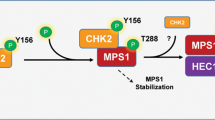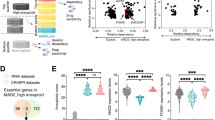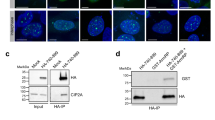Abstract
Defects in chromosomes or mitotic spindles activate the spindle checkpoint, resulting in cell cycle arrest at prometaphase. The prolonged activation of spindle checkpoint generally leads to mitotic exit without segregation after a transient mitotic arrest and the consequent formation of tetraploid G1 cells. These tetraploid cells are usually blocked to enter the subsequent S phase by the activation of p53/pRb pathway, which is referred to as the G1 tetraploidy checkpoint. A human homologue of the Drosophila warts tumor suppressor, WARTS, is an evolutionarily conserved serine–threonine kinase and implicated in development of human tumors. We previously showed that WARTS plays a crucial role in controlling mitotic progression by forming a regulatory complex with zyxin, a regulator of actin filament assembly, on mitotic apparatus. However, when WARTS is activated during cell cycle and how the loss of WARTS function leads to tumorigenesis have not been elucidated. Here we show that WARTS is activated during mitosis in mammalian cells, and that overexpression of a kinase-inactive WARTS in Rat1 fibroblasts significantly induced mitotic delay. This delay resulted from prolonged activation of the spindle assembly checkpoint and was frequently followed by mitotic slippage and the development of tetraploidy. The resulting tetraploid cells then abrogated the G1 tetraploidy checkpoint and entered S phase to achieve a DNA content of 8N. This impairment of G1 tetraploidy checkpoint was caused as a consequence of failure to induce p53 expression by expressing a kinase-inactive WARTS. WARTS thus plays a critical role in maintenance of ploidy through its actions in both mitotic progression and the G1 tetraploidy checkpoint.
This is a preview of subscription content, access via your institution
Access options
Subscribe to this journal
Receive 50 print issues and online access
$259.00 per year
only $5.18 per issue
Buy this article
- Purchase on Springer Link
- Instant access to full article PDF
Prices may be subject to local taxes which are calculated during checkout




Similar content being viewed by others
References
Amon A . (1999). Curr. Opin. Genet. Dev., 9, 69–75.
Andreassen PR, Lohez OD, Lacroix FB and Margolis RL . (2001). Mol. Biol. Cell, 12, 1315–1328.
Hanks SK, Quinn AM and Hunter T . (1988). Science, 241, 42–52.
Hirota T, Morisaki T, Nishiyama Y, Marumoto T, Tada K, Hara T, Masuko N, Inagaki M, Hatakeyama K and Saya H . (2000). J. Cell Biol., 149, 1073–1086.
Hisaoka M, Tanaka A and Hashimoto H . (2002). Lab. Invest., 82, 1427–1435.
Justice RW, Zilian O, Woods DF, Noll M and Bryant PJ . (1995). Genes Dev., 9, 534–546.
King RW, Peters JM, Tugendreich S, Rolfe M, Hieter P and Kirschner MW . (1995). Cell, 81, 279–288.
Kung AL, Sherwood SW and Schimke RT . (1990). Proc. Natl. Acad. Sci. USA, 87, 9553–9557.
Lanni JS and Jacks T . (1998). Mol. Cell Biol., 18, 1055–1064.
Margolis RL, Lohez OD and Andreassen PR . (2003). J. Cell Biochem., 88, 673–683.
Marumoto T, Honda S, Hara T, Nitta M, Hirota T, Kohmura E and Saya H . (2003). J. Biol. Chem., 278, 51786–51795.
Meraldi P, Honda R and Nigg EA . (2002). EMBO J., 21, 483–492.
Minn AJ, Boise LH and Thompson CB . (1996). Genes Dev., 10, 2621–2631.
Nicklas RB . (1997). Science, 275, 632–637.
Nishiyama Y, Hirota T, Morisaki T, Hara T, Marumoto T, Iida S, Makino K, Yamamoto H, Hiraoka T, Kitamura N and Saya H . (1999). FEBS Lett., 459, 159–165.
Shackney SE, Smith CA, Miller BW, Burholt DR, Murtha K, Giles HR, Ketterer DM and Pollice AA . (1989). Cancer Res., 49, 3344–3354.
Shah JV and Cleveland DW . (2000). Cell, 103, 997–1000.
St John MA, Tao W, Fei X, Fukumoto R, Carcangiu ML, Brownstein DG, Parlow AF, McGrath J and Xu T . (1999). Nat. Genet., 21, 182–186.
Tao W, Zhang S, Turenchalk GS, Stewart RA, St John MA, Chen W and Xu T . (1999). Nat. Genet., 21, 177–181.
Toyn JH and Johnston LH . (1994). EMBO J., 13, 1103–1113.
Tugendreich S, Tomkiel J, Earnshaw W and Hieter P . (1995). Cell, 81, 261–268.
Xia H, Qi H, Li Y, Pei J, Barton J, Blackstad M, Xu T and Tao W . (2002). Oncogene, 21, 1233–1241.
Yang X, Li DM, Chen W and Xu T . (2001). Oncogene, 20, 6516–6523.
Yasui Y, Amano M, Nagata K, Inagaki N, Nakamura H, Saya H, Kaibuchi K and Inagaki M . (1998). J. Cell Biol., 143, 1249–1258.
Acknowledgements
We thank all colleagues in Department of Tumor Genetics and Biology, Graduate School of Medical Sciences, Kumamoto University for helpful discussion. We are also grateful to members of the Gene Technology Center and General Research Institute in Kumamoto University for their important contributions to the experiments. This work was supported by a grant for cancer research from the Ministry of Education, Science and Culture of Japan (H. Saya).
Author information
Authors and Affiliations
Corresponding author
Rights and permissions
About this article
Cite this article
Iida, Si., Hirota, T., Morisaki, T. et al. Tumor suppressor WARTS ensures genomic integrity by regulating both mitotic progression and G1 tetraploidy checkpoint function. Oncogene 23, 5266–5274 (2004). https://doi.org/10.1038/sj.onc.1207623
Received:
Revised:
Accepted:
Published:
Issue Date:
DOI: https://doi.org/10.1038/sj.onc.1207623
Keywords
This article is cited by
-
Interaction of LATS1 with SMAC links the MST2/Hippo pathway with apoptosis in an IAP-dependent manner
Cell Death & Disease (2022)
-
Identification and functional classification of differentially expressed proteins and insight into regulatory mechanism about flower color variegation in peach
Acta Physiologiae Plantarum (2019)
-
Premature polyadenylation of MAGI3 is associated with diminished N6-methyladenosine in its large internal exon
Scientific Reports (2018)
-
p53 shades of Hippo
Cell Death & Differentiation (2018)
-
The LATS1 and LATS2 tumor suppressors: beyond the Hippo pathway
Cell Death & Differentiation (2017)



